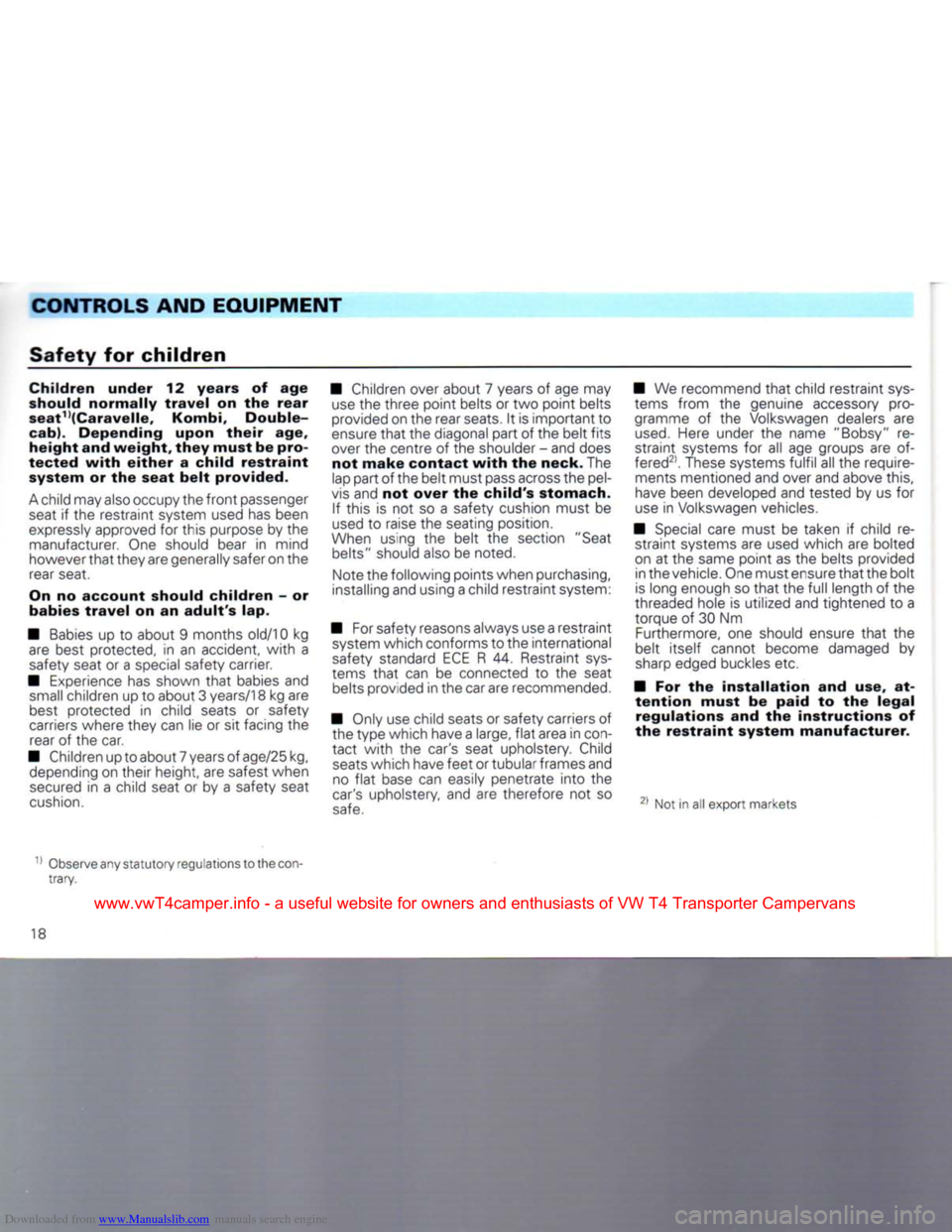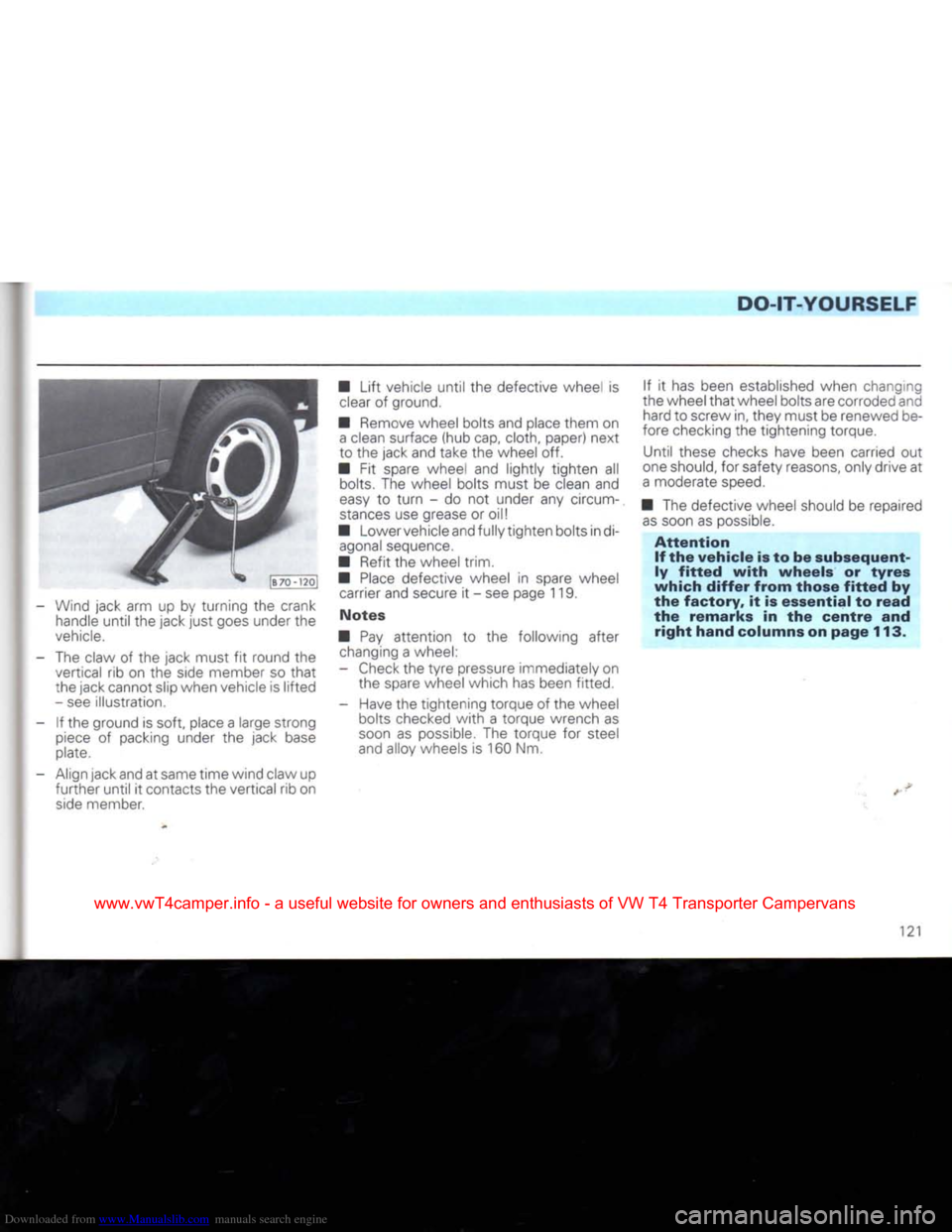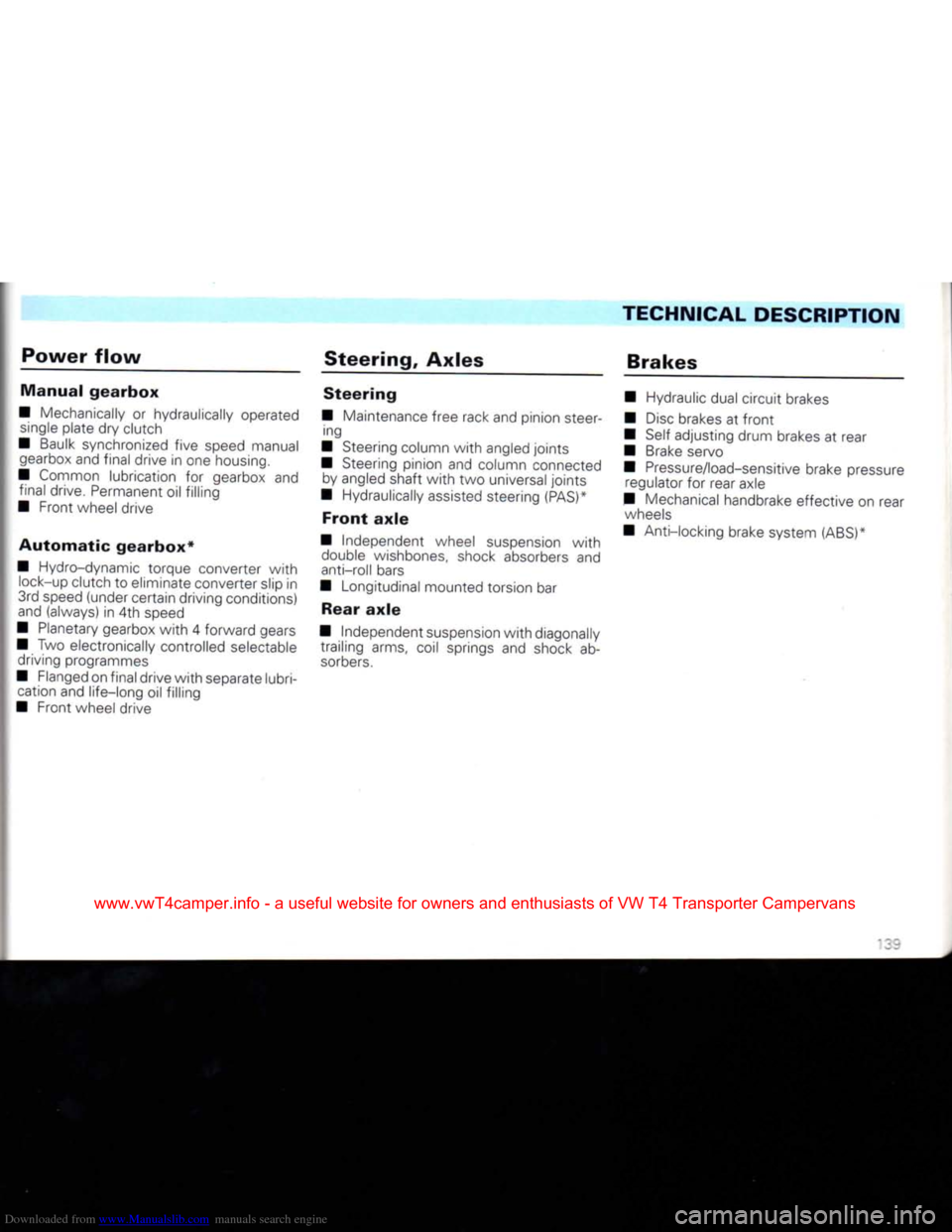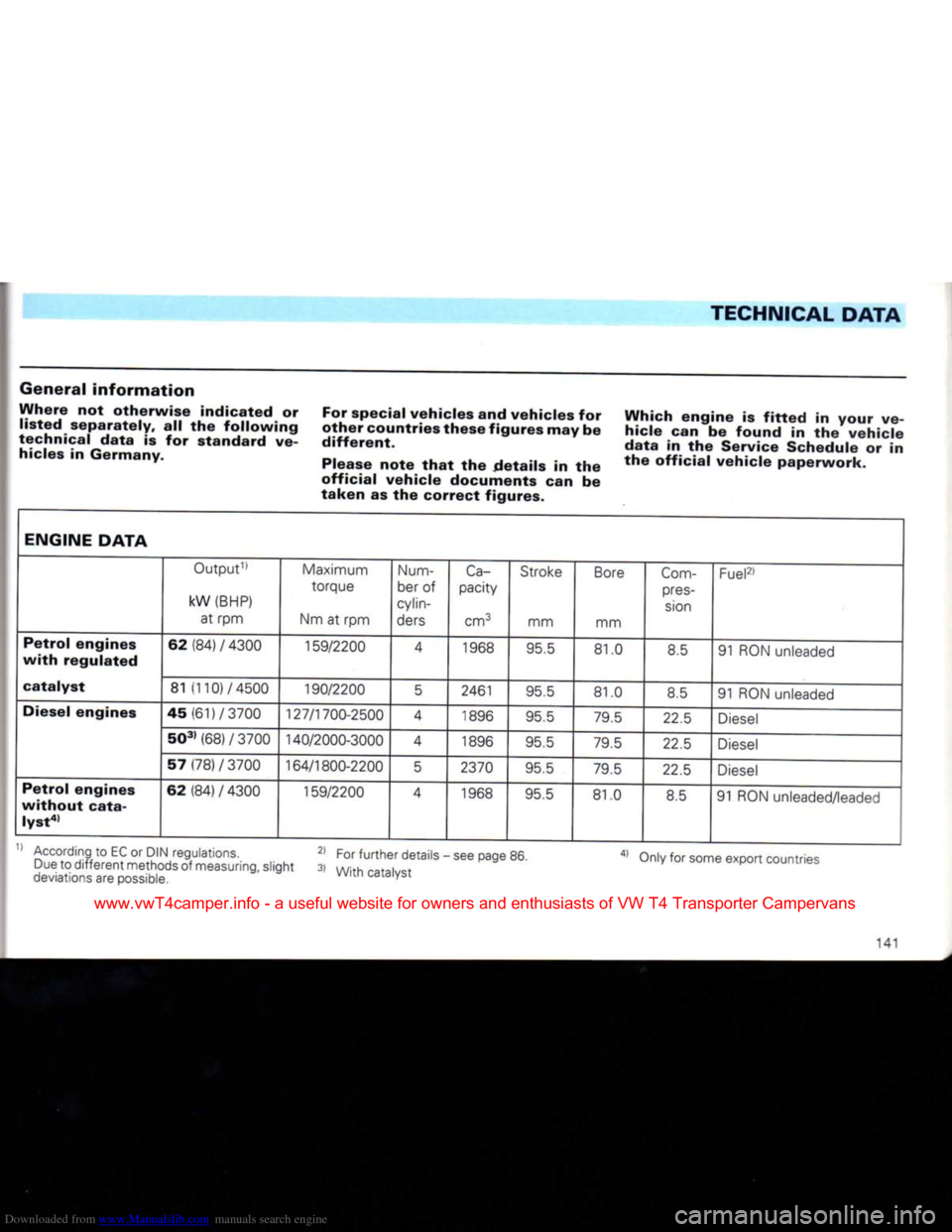1992 VOLKSWAGEN CARAVELLE torque
[x] Cancel search: torquePage 20 of 164

Downloaded from www.Manualslib.com manuals search engine
CONTROLS AND
EQUIPMENT
Safety
for
children
Children
under
12
years
of age
should
normally
travel
on the
rear
seat1>(Caravelle,
Kombi,
Double-
cab).
Depending
upon
their
age,
height
and
weight,
they
must
be pro
tected
with
either
a child
restraint
system
or the
seat
belt
provided.
A
child may also occupy the
front
passenger
seat
if the restraint system used has been
expressly
approved for this purpose by the
manufacturer. One should bear in mind however
that
they are generally safer on the
rear seat.
On no
account
should
children
- or
babies
travel
on an
adult's
lap.
• Babies up to about 9 months old/10 kg are best protected, in an accident,
with
a
safety seat or a special safety carrier.
• Experience has shown
that
babies and
small
children up to about 3 years/18 kg are
best protected in child seats or safety
carriers where they can lie or sit facing the rear of the car.
• Children up to about 7 years of age/25 kg, depending on their height, are safest when
secured
in a child seat or by a safety seat
cushion.
• Children over about 7 years of age may
use
the three point belts or two point belts
provided on the rear seats. It is important to
ensure
that
the diagonal part of the belt
fits
over the centre of the shoulder - and does not
make
contact
with
the
neck.
The
lap part of the belt must pass across the
pel
vis
and not
over
the child's stomach. If this is not so a safety cushion must be
used
to raise the seating position.
When using the belt the section "Seat belts" should also be noted.
Note the following points when purchasing,
installing and using a child restraint system:
• For safety reasons always use a restraint system which conforms to the international
safety standard ECE R 44. Restraint
sys
tems
that
can be connected to the seat belts provided in the car are recommended.
• Only use child seats or safety carriers of the type which have a large,
flat
area in
con
tact
with
the car's seat upholstery. Child
seats
which have feet or tubular frames and no
flat
base can easily penetrate
into
the
car's
upholstery, and are therefore not so
safe.
• We recommend
that
child restraint
sys
tems from the genuine accessory programme of the Volkswagen dealers are
used.
Here under the name "Bobsy" re
straint systems for all age groups are of
fered21.
These systems
fulfil
all the require ments mentioned and over and above this, have been developed and tested by us for
use
in Volkswagen vehicles.
• Special care must be taken if child re straint systems are used which are bolted
on at the same point as the belts provided in the vehicle. One must ensure
that
the bolt
is
long enough so
that
the
full
length of the
threaded hole is utilized and tightened to a
torque of 30 Nm
Furthermore, one should ensure
that
the
belt itself cannot become damaged by
sharp edged buckles etc.
• For the
installation
and use, at
tention
must
be
paid
to the
legal
regulations
and the
instructions
of
the
restraint
system
manufacturer.
Not in all export markets
Observe
any statutory regulations to the
con
trary.
18
www.vwT4camper.info - a useful website for owners and enthusiasts of VW T4 Transporter Campervans
Page 48 of 164

Downloaded from www.Manualslib.com manuals search engine
CONTROLS
AND EQUIPMENT
4
-
Fuel gauge
^u
This gauge works
when
ignition
is
switched on
but it
takes some time for
the
needle
to
reach
its
final
position.
The tank holds about
80
litres.
When
the needle reaches the start of the
re
serve
zone
(arrow)
there is about 10 litres
(2
gallons)
of
fuel left
in the
tank. 5
-
Analog clock
To
set the
time press
the
button
on
lower
right
in
combi instrument:
•
If
pressed briefly, preferably with
a
ball
pen,
the
time
is
advanced
one
minute.
•
If
pressed continuously the minute hand goes faster and
at
the same time
the
hours
are
set as
well.
With
the button the clock can
be set
exactly to
the
second:
•
Press
button until time is one minute be fore time
to be set.
•
Press
button
at the
moment
when
the
seconds indicator
of an
accurate clock
shows
a
full
minute or
when
the time signal is heard
on the
radio. 5
-
Rev counter
*
The
rev
counter needle must not move into
the
red
zone
of the
scale
on any
account.
The additional
red
dotted zone before
the
red zone
on the
scale which some models
have
shows
the
maximum engine speed
permitted
briefly
e.g.
when
overtaking
when
engine
has
been run in and
is
warm
-
see page
76
also.
It is
advisable
to
change up
or
reduce engine speed
at the
latest
by
the time
the
needle reaches this
zone..
rijp
Changing
up in good time helps
<-^>
to
save
fuel and keeps the noise
down.
Change down
to
the next lower gear before
the engine
no
longer runs smoothly.
The green or green shaded area on the scale shows the speed
at
which
the
engine
is de
veloping
its
most favourable torque
and is
working
most economically. Drive
as
often as possible with needle
in
this area.
During
the
running-in
period,
high engine
revs
should
be
avoided.
46
www.vwT4camper.info - a useful website for owners and enthusiasts of VW T4 Transporter Campervans
Page 123 of 164

Downloaded from www.Manualslib.com manuals search engine
DO-IT-YOURSELF
- Wind jack arm up by turning the crank handle
until
the jack
just
goes under the
vehicle.
- The claw of the jack must fit round the vertical rib on the side member so
that
the jack cannot slip when vehicle is
lifted
- see illustration.
- If the ground is soft, place a large strong
piece
of packing under the jack base
plate.
- Align jack and at same time wind claw up
further
until
it contacts the vertical rib on
side
member. •
Lift
vehicle
until
the defective wheel is
clear
of ground.
• Remove wheel bolts and place them on
a
clean surface (hub cap, cloth, paper) next
to the jack and take the wheel off.
• Fit spare wheel and lightly tighten all bolts. The wheel bolts must be clean and
easy
to
turn
- do not under any circum
stances
use grease or oil!
• Lowervehicleand fully tighten bolts indi- agonal sequence.
• Refit the wheel trim.
•
Place
defective wheel in spare wheel carrier and secure it - see page 119.
Notes
• Pay attention to the following after changing a wheel:
- Check the
tyre
pressure immediately on the spare wheel which has been fitted.
- Have the tightening torque of the wheel bolts checked
with
a torque wrench as
soon
as possible. The torque for steel
and alloy wheels is 160 Nm. If it has been established when changing
the wheel
that
wheel bolts are corroded and hard to screw in, they must be renewed be
fore checking the tightening torque.
Until these checks have been carried out
one should, for safety reasons, only drive at
a
moderate
speed.
• The defective wheel should be repaired
as
soon as possible.
Attention
If the
vehicle
is to be
subsequent
ly
fitted
with
wheels
or
tyres
which
differ
from
those
fitted
by
the
factory,
it is
essential
to
read
the
remarks
in the
centre
and
right
hand
columns on
page
113.
121
www.vwT4camper.info - a useful website for owners and enthusiasts of VW T4 Transporter Campervans
Page 141 of 164

Downloaded from www.Manualslib.com manuals search engine
TECHNICAL
DESCRIPTION
Power
flow
Manual
gearbox
• Mechanically or hydraulically operated single plate dry clutch
• Baulk synchronized five speed manual gearbox and final drive in one housing.
• Common lubrication for gearbox and final drive. Permanent oil filling
• Front wheel drive
Automatic
gearbox*
• Hydro-dynamic torque converter
with
lock-up clutch to eliminate converter slip in
3rd speed (under certain driving conditions)
and (always) in 4th speed
• Planetary gearbox
with
4 forward gears
• Two electronically controlled selectable driving programmes
• Flanged on final drive
with
separate lubri cation and life-long oil filling
• Front wheel drive
Steering,
Axles
Steering
• Maintenance free rack and pinion steer ing
• Steering column
with
angled joints
• Steering pinion and column connected by angled shaft
with
two universal joints
• Hydraulically assisted steering
(PAS)*
Front
axle
• Independent wheel suspension
with
double wishbones, shock absorbers and
anti-roll bars
• Longitudinal mounted torsion bar
Rear
axle
• Independent suspension
with
diagonally trailing arms, coil springs and shock ab
sorbers.
Brakes
• Hydraulic dual circuit brakes
•
Disc
brakes at
front
• Self adjusting drum brakes at rear
• Brake servo
• Pressure/load-sensitive brake pressure regulator for rear axle
• Mechanical handbrake effective on rear wheels
• Anti-locking brake system
(ABS)*
www.vwT4camper.info - a useful website for owners and enthusiasts of VW T4 Transporter Campervans
Page 143 of 164

Downloaded from www.Manualslib.com manuals search engine
TECHNICAL DATA
General information
Where
not
otherwise indicated
or
listed separately,
all the
following
technical data
is for
standard
ve
hicles
in
Germany. For special vehicles
and
vehicles
for
other countries these figures
may be
different.
Please note that
the
details
in the
official vehicle documents
can be
taken
as the
correct figures. Which engine
is
fitted
in
your
ve
hicle
can be
found
in the
vehicle
data
in the
Service Schedule
or in
the official vehicle paperwork.
ENGINE DATA
Output11
kW
(BHP)
at
rpm
Maximum
torque
Nm
at rpm
Num
ber
of
cylin
ders
Ca
pacity
cm3
Stroke
mm
Bore
mm
Com
pres
sion
Fuel2'
Petrol engines
with regulated
catalyst 62 (84)
/
4300
159/2200
4
1968
95.5
81.0
8.5
91
RON
unleaded
Petrol engines
with regulated
catalyst
81
(110)/4500
190/2200
5
2461
95.5
81.0
8.5
91
RON
unleaded
Diesel engines 45 (61)/3700
127/1700-2500
4
1896
95.5 79.5
22.5
Diesel
Diesel engines
503>
(68)
/
3700
140/2000-3000
4
1896
95.5 79.5
22.5
Diesel
Diesel engines
57 (78)/3700
164/1800-2200
5
2370
95.5
79.5 22.5
Diesel
Petrol engines
without cata
lyst41
62 (84)
/
4300
1 59/2200 4
1968
95.5
81.0
8.5
91
RON
unleaded/leaded
11 According to EC or DIN regulations. Due to different methods of measuring, slight
deviations are possible. 21 For further details -
31 With catalyst see page 86.
4) Only for some export countries
141
www.vwT4camper.info - a useful website for owners and enthusiasts of VW T4 Transporter Campervans